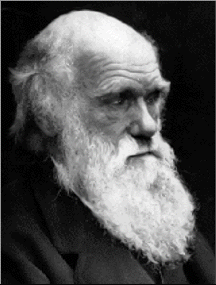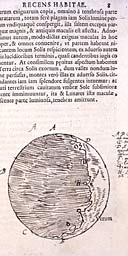Monday, July 31, 2006
Going Bump In the Night
 Jerry Coyne has an article in The New Republic about Ann Coulter that is no more vicious than she herself is. Entitled "Coultergeist," it starts out:
Jerry Coyne has an article in The New Republic about Ann Coulter that is no more vicious than she herself is. Entitled "Coultergeist," it starts out:H. L. Mencken once responded to a question asked by many of his readers: "If you find so much that is unworthy of reverence in the United States, then why do you live here?" His answer was, "Why do men go to zoos?" Sadly, Mencken is not here to ogle the newest creature in the American Zoo: the Bleached Flamingo, otherwise known as Ann Coulter. This beast draws crowds by its frequent, raucous calls, eerily resembling a human voice, and its unearthly appearance, scrawny and pallid.
After noting that Coulter clearly hasn't a clue about the "Darwinism" she rejects (in quotes because it isn't even of the same phylum as the scientific theories that sometimes go by that name), Coyne says:
. . . Coulter was tutored in the "complex ideas" of evolution by David Berlinski, a science writer; Michael Behe, a third-rate biologist at Lehigh University (whose own department's website disowns his bizarre ideas); and William Dembski, a fairly bright theologian who went off the intellectual rails and now peddles creationism at Southwestern Baptist Theological Seminary. These are the "giants" of the ID movement, which shows how retarded it really is. Learning biology from this lot is like learning elocution from George W. Bush.After noting the usual distortions of evolutionary theory brought to the table by such IDeologists, Coyne comments that:
What is especially striking is Coulter's failure to tell us what she really believes about how the earth's species got here. It's clear that she thinks God had a direct hand in it, but beyond that we remain unenlightened. ...Maybe the truest shot that Coyne fires is this:
[W]hen faced with the real evidence that shows how strongly evolution trumps ID, she clams up completely. What about the massive fossil evidence for human evolution--what exactly were those creatures 2 million years ago that had human-like skeletons but ape-like brains? Did a race of Limbaughs walk the earth? ...
There are none so blind as those who will not see, and Coulter knows that myopia about evolution is a lucrative game. After all, she is a millionaire, reveling in her status as a celebrity and stalked by ignorazzis. I have never seen anyone enjoy her own inanity so much.And Coyne's parting words are fitting for the Queen of Mean:
Her case for ID involves the same stupid arguments that fundamentalists have made for a hundred years. They're about as convincing as the blonde hair that gets her so much attention. By their roots shall ye know them.
Sunday, July 30, 2006
Future Designs
 There is a very good article in the Harvard Civil Rights-Civil Liberties Law Review concerning Kitzmiller v. Dover Area Sch. Dist. that can be found in pdf format here. After giving a thumbnail sketch of the events leading up to the trial and the reasoning of Judge Jones, the author, Brenda Lee, turns to the question of the impact the decision will have. Here are some highlights, that I think are right on target:
There is a very good article in the Harvard Civil Rights-Civil Liberties Law Review concerning Kitzmiller v. Dover Area Sch. Dist. that can be found in pdf format here. After giving a thumbnail sketch of the events leading up to the trial and the reasoning of Judge Jones, the author, Brenda Lee, turns to the question of the impact the decision will have. Here are some highlights, that I think are right on target: Although the opinion was excellently written and reasoned, its broad conclusions will not have a great impact on the public debate about teaching evolution and thus will fail to fulfill [Judge Jones'] hope of preventing judicial waste. Given the vast divide in American society over the role of religion in public life, the influence of high profile individuals who favor creationist teaching, and the limited precedential value of a district court’s opinion, lawsuits will continue to serve as the primary check on new and improved methods of including creationism in the classroom. ID is representative of a huge cultural divide in America that a court, despite ambitious goals, cannot mend prophylactically. In fact, the opinion’s decisiveness in finding that ID was not science, based on the overwhelming evidence of the Board’s religious motivations, may encourage critics of evolution simply to repackage their next attack to avoid any mention of religion and thereby escape negative Establishment Clause analysis.
Recent polls show that around eighty percent of Americans believe God created the earth, while acceptance of evolution hovers around fifty percent. This split in opinion was reflected in the media coverage of the Kitzmiller case, when they called it the "latest culture clash between science and religion." ...
[I]f the history of creationism lawsuits is any indication, there will be continued attempts to inject religion into the classroom. Evolution supporters have acknowledged the durability of the creationism movement; as the leader of the Ohio challenge noted, "critical analysis is intelligent design relabeled, just as intelligent design was creationism relabeled. ...
Proponents of evolution can only wait for the next onslaught of creationism, which is likely to be fastidiously stripped of any religious affiliation. How a court will react to this when that time comes remains to be seen.
.
Saturday, July 29, 2006
If At First . . .
Casey Luskin, as I noted yesterday, is mewling again about the alleged "mistake" made by Judge Jones in saying there was no peer-reviewed scientific literature supporting Intelligent Design. As is the case with the Discovery Institute on a depressingly regular basis, this claim is a simple bait and switch with a touch of quote mining thrown in.
First of all, Luskin's argument is identical to one made by Keith Pennock (in a critique of Robert Pennock's take on the Kitzmiller decision), that I have dealt with already.
Essentially, both Pennock and Luskin are making the claim that, since the Judge made a "universal generalization," he is "refuted" if a single counterexample is produced. Or, as Luskin put it, "[t]he question of 'complete absence of peer-reviewed publications' is a simple black and white, binary question: either ID has published peer-reviewed publications, or it hasn't."
In support of this contention that Judge Jones made that simple flat-out claim, Luskin quotes five passages from the decision. Luskin chose to cite to the location of the passages by the page numbers in the Federal Supplement Second, a case law reporter. [1] For the ease of those who may not have access to a law library, I am including the page numbers from the original decision that can be found in a pdf file on the District Court site. As a number of Luskin's examples are only sentence fragments, I am also including the full sentence that they are pulled from, with Luskin's quoted bits in bold:
As we will discuss in more detail below, it is additionally important to note that ID has failed to gain acceptance in the scientific community, it has not generated peer-reviewed publications, nor has it been the subject of testing and research. [p. 64]Now, of course, both Luskin and Pennock are making their own black and white claim about Judge Jones and his decision. Their argument critically depends on whether Jones was saying that there were no peer-reviewed articles at all by ID advocates. Let's look at this in greater context. The following is found on pp. 87-89 (citations are omitted) and encompasses all of Luskin's snippets, except the one from page 64 which is simply a pointer to a discussion that is to come later in the decision:
A final indicator of how ID has failed to demonstrate scientific warrant is the complete absence of peer-reviewed publications supporting the theory. [p. 87]
The evidence presented in this case demonstrates that ID is not supported by any peer-reviewed research, data or publications. [p. 87]
In addition to failing to produce papers in peer-reviewed journals, ID also features no scientific research or testing. [Judge Jones cites to testimony by defense witnesses Steven Fuller and Michael Behe. Fuller's testimony on this point can be found here, on pp. 114-15 and Behe's can be found here on pp. 22-23 and 105-06.]
After this searching and careful review of ID as espoused by its proponents, as elaborated upon in submissions to the Court, and as scrutinized over a six week trial, we find that ID is not science and cannot be adjudged a valid, accepted scientific theory as it has failed to publish in peer-reviewed journals, engage in research and testing, and gain acceptance in the scientific community. [pp. 88-89]
A final indicator of how ID has failed to demonstrate scientific warrant is the complete absence of peer-reviewed publications supporting the theory. Expert testimony revealed that the peer review process is "exquisitely important" in the scientific process. It is a way for scientists to write up their empirical research and to share the work with fellow experts in the field, opening up the hypotheses to study, testing, and criticism. In fact, defense expert Professor Behe recognizes the importance of the peer review process and has written that science must "publish or perish." Peer review helps to ensure that research papers are scientifically accurately, meet the standards of the scientific method, and are relevant to other scientists in the field. Moreover, peer review involves scientists submitting a manuscript to a scientific journal in the field, journal editors soliciting critical reviews from other experts in the field and deciding whether the scientist has followed proper research procedures, employed up-to-date methods, considered and cited relevant literature and generally, whether the researcher has employed sound science.
The evidence presented in this case demonstrates that ID is not supported by any peer-reviewed research, data or publications. Both Drs. Padian and Forrest testified that recent literature reviews of scientific and medical-electronic databases disclosed no studies supporting a biological concept of ID. On cross-examination, Professor Behe admitted that: "There are no peer reviewed articles by anyone advocating for intelligent design supported by pertinent experiments or calculations which provide detailed rigorous accounts of how intelligent design of any biological system occurred." Additionally, Professor Behe conceded that there are no peer-reviewed papers supporting his claims that complex molecular systems, like the bacterial flagellum, the blood-clotting cascade, and the immune system, were intelligently designed. In that regard, there are no peer-reviewed articles supporting Professor Behe's argument that certain complex molecular structures are "irreducibly complex."[17] In addition to failing to produce papers in peer-reviewed journals, ID also features no scientific research or testing.
After this searching and careful review of ID as espoused by its proponents, as elaborated upon in submissions to the Court, and as scrutinized over a six week trial, we find that ID is not science and cannot be adjudged a valid, accepted scientific theory as it has failed to publish in peer-reviewed journals, engage in research and testing, and gain acceptance in the scientific community. ID, as noted, is grounded in theology, not science. ...
[17] The one article referenced by both Professors Behe and Minnich as supporting ID is an article written by Behe and Snoke entitled "Simulating evolution by gene duplication of protein features that require multiple amino acid residues." (P-721). A review of the article indicates that it does not mention either irreducible complexity or ID. In fact, Professor Behe admitted that the study which forms the basis for the article did not rule out many known evolutionary mechanisms and that the research actually might support evolutionary pathways if a biologically realistic population size were used. (Citations omitted)
So it is clear that Judge Jones was not saying there are no peer-reviewed articles that ID advocates allege favor ID, given that he discussed the Behe and Snoke article. Judge Jones was saying that there are no such articles that actively support ID, rather than merely attack some aspect or other of evolutionary theory. None, certainly, that ID proponents were willing to expose to withering cross-examination. [2] Luskin's snippets did not reveal that context and that is the quote mining aspect of his article.
So now we see that Luskin's and Pennock's simple black and white, binary statement that Jones was saying there were no peer-reviewed articles at all has been falsified and their claim that the whole of Judge Jones' decision can be ignored is, by their own argument, proven utterly wrong. Applying their own standards, then, if they can miss so simple a question, how can we trust them on more complicated issues?
Of course, since I neither assume nor hope that everyone who might read this is an idiot or so besotted with sectarian rooting interest as to abandoned any and all of that "critical analysis" the DI talks a lot about but does everything in its power to prevent, let's go a bit further into the real argument.
Given that Luskin can trot out only five articles after nearly two decades of ID "research," far less than the output of peer-reviewed papers in support of evolution in one week, their whole argument winds up, at most, as a literary criticism as to when "vanishingly small" can be said to be the same as "none."
But beyond that remains the issue of what it would take to actively support ID. The DI has been sensitive about accusations of argumentum ad ignorantium, as in this response by Jonathan Witt to an essay in the Wall Street Journal by Kevin Shapiro. As I pointed out then, Stephen Meyer’s article "Not by chance," which is regularly trotted out by the DI as an example of the positive evidence for a designer, has no such evidence at all.
In point of fact, Meyer's argument is classic ignorance layered over what Judge Jones rightly called a "contrived dualism":
1) "Either life arose as the result of purely undirected material processes or a guiding intelligence played a role."
2) There is an "appearance of design."
3) This appearance is "unexplained by the mechanism -- natural selection -- that Darwin specifically proposed to replace the design hypothesis."
DNA functions like a software program. We know from experience that software comes from programmers.
Luskin said the media often misidentifies intelligent design. He offered this definition: It's "a scientific theory that says some aspects of nature are best explained by an intelligent cause because they are identical to objects we commonly know were designed by human intelligence."
Until they can come up with that, we can all just go on correctly stating that there is no support for ID in the scientific literature . . . none, zip, nada, zero.
_______________
[1] As an aside, Luskin cites to the Federal Supplement, a case law reporter that is rarely available outside a law library. After a pretty thorough search, it does not appear that a copy with the Supplement's pagination is available on the web. It has been frequently noted in connection with the Quote Mine Project that, if there are two possible citations to any work, the one cited by creationists is often, if not invariably, to the one more difficult to find. This may explain why Luskin cites to the Federal Reporter rather than to the page numbers contained in the original decision which anyone can obtain on the web here.
[2] Lest anyone repeat Pennock's mistake (which Luskin, as an attorney, would not, of course) mere mention of citations in a proposed Amicus Curia brief does not constitute evidence in Federal or any other court. Judge Jones properly limited himself to the evidence submitted in court.
[3] Concerning the actual nature of the books and papers the ID advocates point to, see "Claim CI001.4: Intelligent design in biology has been supported by several peer-reviewed journals and books" and, on a more mundane level, my prior post, "On Whistling and Graveyards II."
Labels: Quote Mining
Friday, July 28, 2006
Expletive Deleted
 Casey Luskin is over at the Discovery Institute's blog, Evolution News & Views, whining again about Judge Jones' "error" in supposedly stating "that ID has published zero peer-reviewed publications."
Casey Luskin is over at the Discovery Institute's blog, Evolution News & Views, whining again about Judge Jones' "error" in supposedly stating "that ID has published zero peer-reviewed publications." Casey appends the "The Talk Origins Bumper Sticker" shown here. Casey dredges this up because he claims that an article at the Talk Origins Archives cited by John Derbyshire supports their claim about the Judge above. I'll have more to say about this misrepresentation later but for the moment, the funny thing is, if you click on the sticker at the DI's site, you are taken to this pdf file that says:
The TalkOrigins Bumper Sticker. How to Use:
(1) Print the Graphic Below on a Sticker,
(2) Slap it on your Car,
(3) Liberally Cite to Infallible TalkOrigins URLs in E-mails, Blog Posts, Bulletin Boards, Chat Rooms, etc.,
(4) Self-Assuredly Roam the Internet as a "TalkOrigins Expert," and
(5) Make Snide Comments and / or Call "Creationists" all kinds of Nasty Names!
But, hey, Casey! Thanks for letting us know our efforts aren't wasted!
.
Thursday, July 27, 2006
Rethinking Think Tanks
 A think tank has announced a new office that may serve as a balance to the Nondiscovey Institute. The Center for Inquiry / Transnational, the mission statement of which is to promote reason and science in all areas of human interest, said its new Office of Public Policy is a response to a "cultural war on scientific naturalism and enlightenment in general."
A think tank has announced a new office that may serve as a balance to the Nondiscovey Institute. The Center for Inquiry / Transnational, the mission statement of which is to promote reason and science in all areas of human interest, said its new Office of Public Policy is a response to a "cultural war on scientific naturalism and enlightenment in general." The new organization's first white paper was issued this week attacking the veto of federal funding for embryonic stem cell research by President Bush.
But if it is going to match the Boyz from Seattle, where is the budget for dissembling?We intend to develop relationships with sympathetic legislators in D.C. and will provide experts to testify in legislative hearings," said Paul Kurtz, founder and chief executive of the center.
Other goals include submitting amicus briefs in U.S. Supreme Court cases and holding nationally televised press conferences on breaking issues. ...
The center said the stem cell debate is one of several public-policy controversies that have illustrated the need for its scientific expertise. It also cited the teaching of "intelligent design" and the controversy earlier this year over a NASA employee's reported attempts to have "theory" attached to references to the Big Bang.
.
Wednesday, July 26, 2006
Travelin' Man
 Michael Baksa, late of the Dover School District and a star witness in the recent Intelligent Design trial there, is moving on. The Dover School Board had recently refused to renew Mr. Baska's contract as Assistant Superintendent, as well as the contract of the Superintendent Richard Nilsen.
Michael Baksa, late of the Dover School District and a star witness in the recent Intelligent Design trial there, is moving on. The Dover School Board had recently refused to renew Mr. Baska's contract as Assistant Superintendent, as well as the contract of the Superintendent Richard Nilsen. It was widely surmised that the new board, voted in just as the trial was ending and composed of opponents of the ID policy of the old board, took the action in retaliation because Nilsen's and Baska's actions in connection with the policy, particularly their agreement to read the ID statement in class when the teachers refused, may have been perceived as overly willing and contributed to the eventual $1 million dollar cost to the District. Presumably the argument would be that, if Nilsen and Baska had refused to cooperate, the old board might have been forced to abandon the policy.
On the other hand, some board members said that Nilsen and Baska could vie for the jobs when the contacts ended in 2007. Under state law, the board had to inform Nilsen and Baska at this time or their contract would have to be renewed when they ran out next year and it was just an opportunity for the board to see if better candidates could be attracted.
In any event, Baska has now landed the assistant superintendent position, which has been open for about a year, at the Hanover Pennsylvania School District.
Baska's testimony was rather helpful to the plaintiffs in the Dover case and displayed none of the suspicious memory failure about what the board members had said during the run up to the implementation of the policy that Nilsen suffered from. It is only fair to wish him well.
________________
Photo from The Library of Congress American Memory Collection.
Tuesday, July 25, 2006
Feathers and Fuss

There is a frightening story about the abuse a teacher with a 29 year career had to undergo because she taught evolution in a northeast Georgia middle school. Beginning with the 2004-2005 school year, Pat New started teaching evolution to the students in her Life Science class at Lumpkin County Middle School. She had been warned against doing so by other teachers despite the fact that she was just teaching from the book provided to her by the school system.
It is not particularly surprising that parents complained but the attitude of the school officials is puzzling:
She says she was constantly pulled out of her classroom for conferences about why she was teaching Evolution. Once she proved it was part of state standards, the backlash from administrators stopped.
"In 2004, the Spring of 2004, they finally accepted the National Standards for teaching Science. In those national standards Evolution was a big part of it."
But it naturally took its toll:
After her story was picked up by the New York Times she started receiving letters of support from all over the country. She continued teaching throughout the 2006 school year, but then retired a year early. While she has good memories of her ten years in Lumpkin County, the whole battle left a bad taste in her mouth and she's ready to move on.
And I bet there are parents who think that is a good thing for their kids. Evolution isn't the only thing they're dead wrong about.
Monday, July 24, 2006
The Power of Voyaging

Janet Browne, author of the two part biography of Charles Darwin (Voyaging and The Power of Place) that remain the best retelling of his life and work, has an extract from Darwin's Origin of Species: A Biography, part of a series called Books That Shook the World published by Atlantic Books, in the Guardian now.
This piece focuses on the forces that fueled the public controversy. Perhaps surprising to people today and despite the famous, if overblown, "humiliation" of Bishop Samuel ("Soapy Sam") Wilberforce by Thomas Henry Huxley (known as Darwin's Bulldog), there was, as Browne notes, "little sustained opposition to Darwin's book on the grounds that it directly challenged the account of creation in Genesis." In England the Christian churches had, by that time and for the most part, ceded the great age of the Earth and recognized that there had been no global flood. At the same time, Higher Criticism of the Bible had convinced many that the Bible was mostly human in origin. The situation in America was more complex but Darwin's theory, while always controversial among conservative Christians, did receive considerable support among both religious thinkers and religious institutions of higher learning.
Other factors were at work too:
Scholars agree that the course of the Origin controversy was unique in several respects. The book's wide and immediate impact in Britain was greatly enhanced by a growing publishing industry and new review journals. It was greatly enhanced, too, by mid-century peace and prosperity, political stability and imperial expansion. The audience for science was the largest and most appreciative it had ever been, its appetite whetted by the development of local scientific societies, lending libraries, public lectures and exciting practical demonstrations, and reinforced by the broadening availability of manufactured goods and achievements in roads, railways, bridges, ships and canals. Writings such as Chambers's Vestiges and Tennyson's In Memoriam already helped readers explore the big issues of human existence, questions of origin, meaning and purpose.
Sunday, July 23, 2006
Fabulous Animals, Fabulous Site

I've been reading Erik Nordenskiöld's The History of Biology and have reached the Renaissance (okay, make that slowly reading). The Renaissance thinkers were deeply enamored of Aristotle, even as they laid the foundations for the overthrow of the Scholastic method of appeal to authority rather than observation.
Among the changes in biology in the Renaissance was the rise of purely descriptive biological literature and the use of illustrations. One of the earliest practitioners was Konrad Gesner (1516-1565) and his Historia animalium was widely influential. While he still, as was common in the medieval bestiaries, included literally fabulous animals (such as a sea serpent of ship-eating proportions), his illustrations were often strikingly accurate, as in the case of that fine fellow shown here, chosen in honor of PZ Mierse and his Friday Cephalopods.
The National Library of Medicine has a wonderful reproduction, in color, of Gesner's book that really feels like you are turning the pages (just click on "Turn The Pages" and then on the cover). It also includes audio and written commentary on the text and an enlargement tool that feels like you are using a magnifying glass. Furthermore, there is a Gallery of images where many of the illustrations can be found in a format that allows for even greater enlargement for even closer study.
Other works in this format include Ambroise Paré's Oeuvres, Andreas Vesalius's De Humani Corporis Fabrica and Johannes de Ketham's Fasiculo de Medicina.
This is one of the best uses of the web I've seen.
Saturday, July 22, 2006
Speaking of Charles

Darwin's understanding of nature never departed from a theological point of view. Always, I believe, until his dying day, at least half of him believed in God. He said he deserved to be called an agnostic, but he did make the point later in life that "when I wrote The Origin of Species, my faith in God was as strong as that of a bishop.".
Friday, July 21, 2006
Creation Capers

Is there something about creationism that makes people incapable of anything but the most ham-fisted humor? We've already seen Ann Coulter's bilious raccoon. Now Casey Luskin of the Discovery Institute has at a quilter named Barbara West who created an "attack" on Intelligent Design (never mind that she called it poking some fun at the ID debate) that won a national prize in Canada.
Beginning with more than we might want to know about his angst at being pushed out of the nest as a young adult, Casey tells the story of Bertrand Russell's supposed encounter with the old woman who insisted that the Earth was carried on the back of a giant turtle. When Russell slyly asked what the turtle stood on, the old woman was alleged to have responded that it was "turtles all the way down."
After recounting the story, that Ms. West got from Stephen Hawking’s A Brief History of Time and that inspired her quilt showing eight giant Galapagos tortoises one on top of the other with the earth sitting precariously on the back of an orange-shelled one, Luskin launches into a knee-slapping discourse on Aristotelian ultimate and efficient causes that Jay Leno is bound to be repeating any time now.
In perhaps the most sensible part of the piece, Casey made sure to tell us that it is all meant "in good fun," just in case the ancient metaphysical hilarity has somehow escaped anyone.
By the way, Ms. West deserves better than this, as she is quite a good artist in her own right, as this piece, based on plankton drawn by Ernst Haeckel, clearly shows:

Thursday, July 20, 2006
The Ploy's the Thing . . .
 The Harrison County (West Virginia) Board of Education had another meeting July 18th but apparently did not vote on the issue of whether or not to remove the portrait of Jesus from the hallway outside the principal's office. Nor has the board decided on whether to accept any of the six offers of free legal representation it has received in the case.
The Harrison County (West Virginia) Board of Education had another meeting July 18th but apparently did not vote on the issue of whether or not to remove the portrait of Jesus from the hallway outside the principal's office. Nor has the board decided on whether to accept any of the six offers of free legal representation it has received in the case. Frankly, it is hard to see how this can end well for the district. The Sixth Circuit Court of Appeals has already decided a quite similar case, finding the placing of a portrait of Jesus in the hallway of a public school unconstitutional in Washegesic v. Bloomingdale Public Schools, 33 F.3d 679 (6th Cir. 1994), which, unfortunately, is not on the web that I can find.
The closest thing to a "justification" I can find for keeping the portrait is this bizarre screed by Michael Queen, a newly seated member of the Harrison County School Board, taking his place only after the original vote.
The basic theme is that the portrait is "on loan" to the principal from a retired counselor who had it hanging in his office. Supposedly, this picture has hung in one spot or the other for the last 35 years (a non sequitur since Constitutional violations don't disappear with age). The crux of the "defense" is that "[t]he decision to hang the portrait up in his office is Lindy Bennett's (the school's principal) constitutionally protected right to freely express his personal opinion."
About the only thing that can be said about that claim is that someone must have gotten a hold of William Buckingham's oxycontin. It is stunning that anyone might consider for a moment that such a lame story could fly in a federal courtroom.
The only thing worse is the quote mining of the Supreme Court that follows:
The Supreme Court is very clear that "the right for one to freely express themselves regarding their religious preferences or beliefs does not stop at the schoolhouse door".
Under what is now called the Pickering balancing test (refering to the Supreme court case, Pickering v. Board of Ed. of Tp. High School Dist. 205, Will County, 391 U.S. 563, 88 S.Ct. 1731), public employees like plaintiff teacher do not leave their First Amendment rights at the schoolhouse door . . .
Queen attempts to muddy the waters by asking if a teacher could wear a cross as jewelry or have ashes on his or her head from Ash Wednesday mass but is unconvincing because of the clearly personal, and not official, nature of such items. That is considerably different from a portrait associated with the most "official" part of the school, the principal's office. Nor is the example of having "meat free" meals on Friday during Lent apropos. Accommodating all students religious beliefs in such matters is not only permissible but probably required. Thus there should also be pork-free meals for Jewish and Moslem students. But an attempt to justify this portrait on that grounds admits the claim about the principal expressing his rights is bogus and raises the question of what visual accommodation is being made for non-Christian students.
Then Mr. Queen shows the nature of his real concerns which (surprise, surprise!) have nothing to do with the welfare of the children in the district:
Will the white crosses marking the graves of our military men and women be taken down? Will the Ten Commandments and symbols of Christianity be removed from our federal buildings and courthouses?
Will Congress have to stop offering a prayer at the beginning of every day? Will Congress have to get rid of their tax-paid chaplains?
Unfortunately for the children of Harrison County, the only good Mr. Queen may do for their education is serve as an example of how dangerous ideologues are to good government.
Wednesday, July 19, 2006
Gambling With Science
Frequent pollster to the IDeratti, John Zogby, has called the veto "a huge gamble by the president." because Bush already
. . . is viewed as anti-science whether it comes to creationism, stem cell research, the environment, global warming, a whole host of issues. Those could be aces in the hole for Democrats.
It adds to their sense of disappointment or frustration or anger," he said, calling the image of Bush as anti-science cumulative with the veto, coming on top of Bush’s interference in the Terry Schiavo case, skepticism about global warming, questioning of evolution and opposition to forms of contraception.
Still, Bush's stance on science is not likely to be a top issue in November's elections, where the War in Iraq may well drown just about everything else out. Perhaps the most that can be expected is that, as Sherry Bebitch Jeffe, of the University of Southern California, said:
It could make some moderate Republicans in less-than-comfortably safe districts a little nervous They’ve either got to go along with their president and be questioned, or oppose the president and anger the base.
Tuesday, July 18, 2006
With Friends Like These . . .
So far, I have laid off Kent Hovind's latest problems with the law. Tromping on Hovind now has much in common with "sports" involving fish, barrels and sticks of dynamite.
But now that he has plead not guilty "under duress," (for no doubt totally unconscious humor purposes), I just want to note that once when he was questioned about whether he really had the money to pay the $250,000 offer he had (bogusly) made, he said "A wealthy friend of mine has the money in the bank."
I guess we all know who that "friend" was now.

Monday, July 17, 2006
Past Due Payment
 .
.The Rev. Barry W. Lynn, an ordained minister in the United Church of Christ and executive director of Americans United for Separation of Church and State which, along with the ACLU, is representing the plaintiffs, has an editorial in The Charleston Gazette explaining the rationale of the suit:
A portrait of Jesus is appropriate for homes, churches or private religious schools. But Bridgeport High is none of those things. It is a place where students of all religious backgrounds (and none) should be made to feel welcome and a part of the school community. ...
Religious belief is properly fostered by parents in the home and places of worship. Moms and dads have the right and responsibility to make decisions about what religious training their children receive. When educators or politicians interfere with that parental role, they tread on unconstitutional ground.
The funny thing is that often the same people who support this kind of government intrusion into religion are firmly convinced that government is incapable of dealing correctly with such relatively unimportant (if Christ was to be believed) areas of life as economic policy, but they nonetheless gladly turn their children's souls over to local political hacks.
A vote was taken by the school board on June 6 that ended in a tie and, therefore, resulted in the portrait staying where it was. Another vote is scheduled to take place tomorrow, July 18th. As Lynn notes, if the board continues to refuse to remove the portrait, the district can become responsible for the plaintiff's legal fees, just as the Dover School District did. While a case like this, which might well be decided on summary judgment without the unusually extensive trial that took place in Kitzmiller v. Dover School District, is unlikely to approach the $1 million settled on in Dover, it can still be expensive indeed.
They may have a friend in Jesus in Harrison County, but does he have deep pockets?
.
Sunday, July 16, 2006
How the Mighty . . .
And I had a minor accident today (I think I'm okay but I may not be dancing the Macarena anytime soon . . . but that was a pretty sure bet anyway). I may not be up to much for a day or two (depending on the strength of pain killer I can wheedle out of the doctor).
Here is the post at PZ's place.
And the debate in talk origins (between Larry and I) starts here.
Just go ahead and pretend it all happened here.
__________________
* Inside joke from talk.origins, where PZ once complained about his students misspelling his name.
Friday, July 14, 2006
Friendliest Fire

The Vatican might keep Stuart Baker, the current White House Director of Lessons Learned, in mind when he comes to the end of his tenure. Then again, if this Administration's record is any indication, maybe it should pass on Mr. Baker.
On the other hand, the Catholic hierarchy clearly needs someone to remind them of past (you should pardon the expression) sins.
Destroying human embryos is equivalent to an abortion. It is the same thing . Excommunication will be applied to the women, doctors and researchers who eliminate embryos [and to the] politicians that approve the law.
I can bear excommunication. I was raised as a Catholic, I share Catholic values, but I am able to make my own judgment on some issues and I do not need to be told by the church what to do or to think.
Thursday, July 13, 2006
Yourcology and Mycology
 At long last, your tax dollars put to good use:
At long last, your tax dollars put to good use: Volunteers who tried the hallucinogenic ingredient in psychedelic mushrooms during a controlled study funded by the U.S. government had "mystical" experiences, and many of them still felt unusually happy months later.
The study included 36 college-educated participants averaging 46 years of age. It was also randomized and double-blinded, meaning that half of the participants received psilocybin, while the other half received a non-hallucinogenic stimulant, methylphenidate (Ritalin), but neither researchers nor the participants knew who got which drug in any given session. Each volunteer was brought in for two or three sessions in a "crossover" design that guaranteed that each participant used psilocybin at least once.
. . . nearly two-thirds of the volunteers said they achieved a "mystical experience" with "substantial personal meaning." One-third rated the psilocybin experience as "the single most spiritually significant experience of his or her life," and another 38 percent placed the experience among their "top five" most spiritually significant moments.
Most also said they became better, gentler people in the following two months. "We don't think that's delusional, because we also interviewed family members and friends by telephone, and they confirmed these kinds of claims . . . "
"More than 60 percent of the volunteers reported effects of their psilocybin session that met the criteria for a 'full mystical experience' as measured by well-established psychological scales," said lead researcher Roland Griffiths, a professor in the departments of neuroscience, psychiatry and behavioral biology at Johns Hopkins University in Baltimore.
Photo of mushrooms via Documen Information Design.
.
A Schmear for Your Bagel?
I think it’s a smear campaign because everybody knows there are an awful lot of people who do believe that evolution is atheistic and that they are trying to tar us and other people who accept the committee’s standards as atheists.
But is being an atheist something so disreputable or so lacking in moral character as that the mere unsupported charge constitutes a smear?
I think we may have identified the problem with Kansas.
Tuesday, July 11, 2006
Gee Whiz, A Quote Mine
 The folks over at the Discovery Institute have been working the quote mines again, leaving nothing but scant tailings of their intellectual and moral integrity.
The folks over at the Discovery Institute have been working the quote mines again, leaving nothing but scant tailings of their intellectual and moral integrity.Henry Gee, chief science writer for Nature... [wrote:] "No fossil is buried with its birth certificate" ... and "the intervals of time that separate fossils are so huge that we cannot say anything definite about their possible connection through ancestry and descent." It's hard enough, with written records, to trace a human lineage back a few hundred years. When we have only a fragmentary fossil record, and we're dealing with millions of years -- what Gee calls "Deep Time" -- the job is effectively impossible... Gee concludes: "To take a line of fossils and claim that they represent a lineage is not a scientific hypothesis that can be tested, but an assertion that carries the same validity as a bedtime story -- amusing, perhaps even instructive, but not scientific."
I have become somewhat irked lately at the way that some creationists continue to attribute beliefs to me to which I do not subscribe. For example, creationists of the 'intelligent design' tendency have used my book Deep Time (sold in the US as In Search of Deep Time) to suggest that whereas I don't support their views, my own work somehow legitimises them . . .
Labels: DI Quote Mining, Quote Mining
Monday, July 10, 2006
Scopes It Out!
 There is a good summary (except for some quibbles, such as stating that there is a specific denomination with well-defined beliefs called "Fundamentalism") of a number of the more misunderstood aspects of the Scopes "Monkey Trial" at the American Heritage site. The article, "20 Questions About the Scopes Trial," by Frederic D. Schwarz, can be found here.
There is a good summary (except for some quibbles, such as stating that there is a specific denomination with well-defined beliefs called "Fundamentalism") of a number of the more misunderstood aspects of the Scopes "Monkey Trial" at the American Heritage site. The article, "20 Questions About the Scopes Trial," by Frederic D. Schwarz, can be found here. The article is no substitute for Edward J. Larson's Pulitzer Prize winning Summer for the Gods, but it does cover many of the myths that have come to surround the trial, mainly due to the failure to distinguish the play Inherit the Wind, staring Paul Muni, and the later movie, with Spencer Tracy and Frederic March, from real history. Inherit the Wind, much like Arthur Miller's The Crucible, was originally intended as a parable about McCarthyism and not an accurate account of the Scopes trial, though the marketing of the Stanley Kramer movie may have blurred that distinction. In any event, the article is a useful balance against the worst of the mythmaking.
Sunday, July 09, 2006
Pssst! . . .
Past examples include William Dembski, Phyllis Schlafly and David Klinghoffer here. Sen. Rick Santorum stubs his toe here; Kansas State Senator Kay O’Connor does the same here and Kansas Board of Education Chairman Steve Abrams makes it a political threesome here.
The latest to inadvertently blurt out the truth, but hardly the most surprising given his general cluelessness, is Dave Scot. In case you don't know, Dave is in charge of making a laughing stock out of William Dembski's old blog, Uncommon Descent, and has done a bang-up job in that regard at least.
As first noted by Ed Brayton over at Dispatches from the Culture Wars, Dave, with a seemingly bottomless supply of inanity, has taken to spreading it around. The following comes from a particularly dense effort at Larry Fafarman's blog to blame the plaintiffs in the Dover case for the $1 million in costs resulting from the school board's ID policy. That Dave is encouraging the supposedly God-fearin' folks of Dover to start heating up some tar and emptying feather pillows should not distract from Dave's admission. Dave's religion my be execrable but it is still religion. Anyway here is Dave forgetting the party line that ID is divorced from religion:
The bottom line remains that 11 snotty parents hated religion so much they thought it was worth taking a million dollars from the school district so their children didn't have to be burdened with either hearing that 60 second blurb or excusing themselves from it.
Navigating Continents of Origin
An editorial in The New England Journal of Medicine in 2001 said race was a "social construct, not a scientific classification," and denounced "race-based medicine," including "medical research arbitrarily based on race." The editorial concluded that "in medicine, there is only one race — the human race."
Such high-minded sentiments sound pretty good. But the same issue of the journal also included an article and another editorial suggesting there were some important racial differences in the way people reacted to various medicines, including drugs used to treat high blood pressure, heart failure, depression and pain. The differences could affect the dose a person needed, or whether a particular drug should be used at all.
It's a very explosive issue. And for a good reason. The whole concept of race has been abused blatantly in the past and egregiously misused in order to accomplish very distasteful ends socially and politically. ...
The question remains, does any of the differential distribution of gene forms have potential medical significance? I think the answer is, sure. There may be differentially distributed genotypes that put a group, in aggregate, at increased or decreased risk for certain diseases or affect their responses to certain medications.
To avoid the charged word "race," "continent of origin" is being used more and more and may reflect the useful information better anyway. Dr. Lisa A. Carey, the medical director of the University of North Carolina at Lineberger says:
I agree with people who say race is an artificial construct. It has limited usefulness now, as a proxy for ancestral geographic region.
It's what we have. If it gives us some information it's better than no information.
Saturday, July 08, 2006
The Prophet (sp?) of Flatulence

Ann Coulter's book (to the extent it is hers), Godless: The Church of Liberalism, contains a ham-fisted attempt to mimic the whimsy of the Flying Spaghetti Monster, which was created to mock the ID-spouting biblical literalists on the Kansas School Board. Coulter's stab at humor is called the "Flatulent Raccoon Theory."
Throw in enough words like imagine, perhaps, and might have -- and you've got yourself a scientific theory! How about this: Imagine a giant raccoon passed gas and perhaps the resulting gas might have created the vast variety of life we see on Earth. And if you don't accept the giant raccoon flatulence theory for the origin of life, you must be a fundamentalist Christian nut who believes the Earth is flat. That's basically how the argument for evolution goes [emphasis in original]. (p. 214)
Why is it that the clueless always wind up in such obvious projection, if not unconscious self-parody?
Anyway, there is now a massive and (to the extent I've been able to go through it so far) excellent point-by-point refutation by Robert Savillo of the supposed "controversy" about evolutionary theory set out in Coulter's book which, according to William Dembski, is an accurate summation of the case against evolution that the Kansas standards are supposed to encourage.
Case closed, then.
Friday, July 07, 2006
Following the Rules Religiously
Therefore, for your edification, here are the:
10 Commandments of the Separation of Church and State:
1. Neither a state nor the Federal Government can set up a church.
2. Neither a state nor the Federal Government can pass laws which aid one religion, aid all religions, or prefer one religion over another.
3. Neither a state nor the Federal Government can force nor influence a person to go to or to remain away from church against his will.
4. Neither a state nor the Federal Government can force a person to profess a belief or disbelief in any religion.
5. No person can be punished for entertaining or professing religious beliefs.
6. No person can be punished for entertaining or professing religious disbeliefs.
7. No person can be punished for church attendance or non-attendance.
8. No tax in any amount, large or small, can be levied to support any religious activities or institutions, whatever they may be called, or whatever form they may adopt to teach or practice religion.9. Neither a state nor the Federal Government can, openly or secretly, participate in the affairs of any religious organizations or groups.
10. No religious organizations or groups can, openly or secretly, participate in the affairs of a state or the Federal Government..
Thursday, July 06, 2006
ID's Right Brain Goes Wrong
Wagner gives three examples of "ID art" that can be seen at Stranger Fruit. Let's just say that the best art has the least to do with design. And the selection of a cartoon depicting ID as the Visigoths storming the walls of Academia is just jaw-droppingly clueless.
At least the baroque Rome of Urban VIII had Bernini to ease the pain of the decline. Intelligent Design can only offer cartoons.
The Art of Science

There is an interesting take on the relationship of science and art in Renaissance Italy and how the same forces may have killed off both. The impetus for the article, "Ways of seeing," by Jonathan Jones, is the opening of an exhibition at Compton Verney in Warwickshire, England called The Starry Messenger, which takes Galileo's book of that name as a starting point for an exploration of cosmic imagery in art.
The fate of Galileo is one of the iconic stories of modern times. We think of it as a story about science. But in Renaissance Italy, there was no separation between art and science. Artists were at the forefront of scientific research - Leonardo da Vinci championed experiment a century before Galileo, and even anticipated, without a telescope, his observation that light reflected off the Earth illuminates the moon. Galileo refers to Da Vinci's Precepts on Painting, which means he had access to Da Vinci's notebooks. He praises Raphael and Titian, and uses Michelangelo as an image of the mystery of creation.
Galileo was an art lover - and when he came before the Inquisition in 1633, he was prosecuted by other art lovers. The centrality of this story to the world of baroque Rome has been censored from cultural history. Galileo was confronted by the Barberini family, patrons of Bernini, of the florid ecstatic style of the baroque. Maffeo Barberini, Pope Urban VIII, commissioned Bernini's Disney excesses that give the finishing touch to the interior of St Peter's; and it was this Barberini Pope who took personal offence at Galileo's Dialogue, believing some of Simplicio's words parodied him. Which they doubtless do.
When Galileo was silenced, you could see this as the triumph of the baroque way of seeing the world over the scientific tradition of the Renaissance. ...
. . . The art of baroque painters owes nothing to observation, nothing to that loving examination of the visible that makes the art of Da Vinci or Titian, and the science of Galileo, so alive. Baroque art looses itself from nature and, for a moment, that is liberating - but compare any of it with the Renaissance and it is a fall.
I have no idea whether Jones is right about the fall of art and the fall of science being connected but, in a way, I hope it is true. For one thing, it would confirm, in an indirect but very persuasive way, that science feeds off the same impulse in humans to strive for truth and beauty that fuels art. And it would promise that science, like art, survives the assaults of the barbarian and the despot and is subversive of all things that would crush the spirit of our species.
.
Tuesday, July 04, 2006
Darwin and God, Together Again?
Of particular note is his take on which approach by pro-science advocates he found most convincing. Roughly speaking, there are those who are willing to accommodate the religious sensibilities of lay people and those who are not. That divide is epitomized by Dawkins, for the uncompromising school and Gould for those willing to separate science and religion.
Bunglawala had this assessment of the two:
Dawkins' work was forcefully argued and took no prisoners from the creationist camp; however, I did find his militant atheism quite off-putting (Madeleine Bunting was right in my view in arguing that Dawkins' approach unwittingly plays into the hands of creationists).
Gould on the other hand, while no less erudite and harbouring the same contempt for the pseudo-science utilised in creationist arguments, presented his case in a graceful manner and sought to convince his readers that biological evolution was the proper arena of science, not religion. And just as it was important for religious scholars not to overstep their boundaries by making unsupported assertions about issues that were within the domain of science, he also gently chided those scientists who made similarly unsupported atheistic claims about what evolution had to say regarding questions of meaning and purpose - questions that have traditionally been the domain of religion.
If its encounter with evolution is not to turn out to be Islam's Galileo moment then Muslim scientists have a crucial responsibility to engage in frank discussion about it with students and with religious scholars in an open and honest manner to help address a dogmatic aloofness which can only harm future Muslim science students.
Working In the Quote Mines
One has only to contemplate the magnitude of this task to concede that the spontaneous generation of a living organism is impossible. Yet here we are -- as a result, I believe, of spontaneous generation. - George Wald, Harvard University biochemist and Nobel Laureate, 1954
The source of the above quote is an article Wald wrote, entitled "The Origin of Life," that appeared in the August 1954 issue of Scientific American (vol. 191), on pages 44-53. This is the same article that was ultimately the source of Quote Mine # 57.
As was the case with Quote Mine # 57, the creationists have frequently mangled the citation in passing around the quote. The "Journey" site above gives the source as "George Wald, 'The Origin of Life,' Scientific American, 191:48, May 1954" as does The Triunity Report: The Origin of Life and The Suppression of Truth. Another site, Adventist Review: The Simple Cell?, gives it as "Scientific American, May 1954." The latter site goes on to merge this quote mine with a variation on Quote Mine # 57, which itself was a paraphrase of what Wald said that bore little resemblance to his actual point, thus creating a true paragon of misinformation.
One has only to contemplate the magnitude of this task to concede that the spontaneous generation of a living organism is impossible. Yet here we are -- as a result, I believe, of spontaneous generation. It will help to digress for a moment to ask what one means by "impossible."
When one has no means of estimating the probability beforehand, it must be determined by counting the fraction of successes in a large number of trials.
Our everyday concept of what is impossible, possible or certain derives from our experience: the number of trials that may be encompassed within the space of a human lifetime, or at most within recorded human history. In this colloquial, practical sense I concede the spontaneous origin of life to be "impossible." It is impossible as we judge events in the scale of human experience.
We shall see that this is not a very meaningful concession; For one thing, the time with which our problem is concerned is geological time, and the whole extent of human history is trivial in the balance.
More importantly, though:
When we consider the spontaneous origin of a living organism, this is not an event that need happen again and again. It is perhaps enough for it to happen once. The probability with which we: are concerned is of a special kind; it is the probability that an event occur at least once. To this type of probability a fundamentally important thing happens as one increases the number of trials. However improbable the event in a single trial, it becomes increasingly probable as the trials are multiplied. Eventually the event becomes virtually inevitable.
Consider a reasonably improbable event, the chance of which is 1/1,000. The chance that this will not occur in one trial is 999/1,000. The chance that it won't occur in 1,000 trials is 999/1,000 multiplied together 1,000 times. This fraction comes out to be 37/100. The chance that it will happen at least once in 1,000 trials is therefore one minus this number -- 63/100 -- a little better than three chances out of five. One thousand trials have transformed this from a highly improbable to a highly probable event. In 10,000 trials the chance that this event will occur at least once comes out to be 19,999/20,000. It is now almost inevitable.
Time is in fact the hero of the plot. The time with which we have to deal is of the order of two billion years. What we regard as impossible on the basis of human experience is meaningless here. Given so much time, the "impossible" becomes possible, the possible probable, and the probable virtually certain. One has only to wait: time itself performs the miracles.
The important point is that since the origin of life belongs in the category of at-least-once phenomena, time is on its side. However improbable we regard this event, or any of the steps which it involves, given enough time it will almost certainly happen at least once. And for life as we know it, with its capacity for growth and reproduction, once may be enough.
Creationists are free to dispute Wald's arguments or his conclusions, of course. In fact, he accepts, based on the evidence available in 1954, that there was some 2 billion years between the point that conditions on Earth made life possible and its first appearance. Evidence discovered in the 50 years that have passed since Wald's article suggests that liquid water first appeared on the Earth about 4.4 billion years ago, while the earliest fossils found are dated at 3.5 billion years ago and the earliest (though disputed) signs of life date to 3.8 billion years ago. It is not immediately obvious that 700 million years or so is insufficient for Wald's argument to be valid.
Ultimately, the question of whether the arguments Wald advanced were right is not the point here. The quote miners could have set out Wald's arguments and tried to make a case against them and no one could have complained. They chose, instead, to misrepresent his arguments in an attempt to hijack Wald's reputation. They succeeded only in ruining their own.
____________
* There were a number of letters about Wald's article published in the October 1954 issue of Scientific American. One of them makes a crude attempt to argue that the term "trial" implies a conscious "trier," which Wald, in a response to the letters, disposes of by pointing out that he "meant only an event to whose outcome one might attach a probability."
More interestingly, a professor R. L. Probst refers to Human Destiny, a book by Lecomte du Noüy, that, in turn, claims that calculations made by Professor Charles-Eugène Guye about the formation of proteins showed that:
. . . the time needed to form, on an average, one such molecule in a material volume equal to that of our terrestrial globe is about 10^243 billion years. But we must not forget that life appeared about one billion years ago.... We are faced with an interval which is more than 10^243 times too short.
I will admit that the scientist should try to explain events by natural causes, without bringing in the intervention of God, as long as it is possible and reasonable to do so. But science demands that a theory have some solid evidence supporting it.: Therefore, to hold that life has developed spontaneously by chance is not a scientific' statement; it is a sheer act of faith, perhaps based on a prejudice against admitting the action of an agent outside of the material universe.
As to the supposed calculations, Wald reiterates that:The Jesuit priest, John Turberville Needham, a great champion of spontaneous generation, believed that God created matter initially with the potentiality of spontaneously generating life. Indeed, as pointed out in my article, this belief is consonant with the relevant passages in the Book of Genesis [that God bade the earth and waters to bring forth plants and animals]. If Professor Probst is dissatisfied with this view, where does he believe that God intervened? Was it to create the first protein? Or the first living cell? Or a man?
By the way, Guye was a physicist who died in 1942 and was calculating the odds of atoms lining up by accident to form a protein if a vessel the size of the Earth with the constituent atoms was mechanically shaken at the speed of light. In other words, like Hoyle, he was someone outside his area of expertise, calculating "odds" based on utterly unrealistic premises that have nothing to do with biochemistry as we know it, much less any realistic hypotheses about abiogenesis.. . . no adequate basis exists for such a calculation. We are concerned here with the probabilities associated with a series of stepwise reactions and aggregations, none of which perhaps exceeds the bounds of what may happen in a two-body collision.
I wonder how one might have assessed the probability that a mixture of water vapor, methane, hydrogen and ammonia, passed for a week over an electric spark, could form a variety of amino acids in relatively high yield. Yet in 1953 Miller showed that this happens, and our entire conception of its intrinsic probability is revised accordingly.
Labels: Quote Mining




